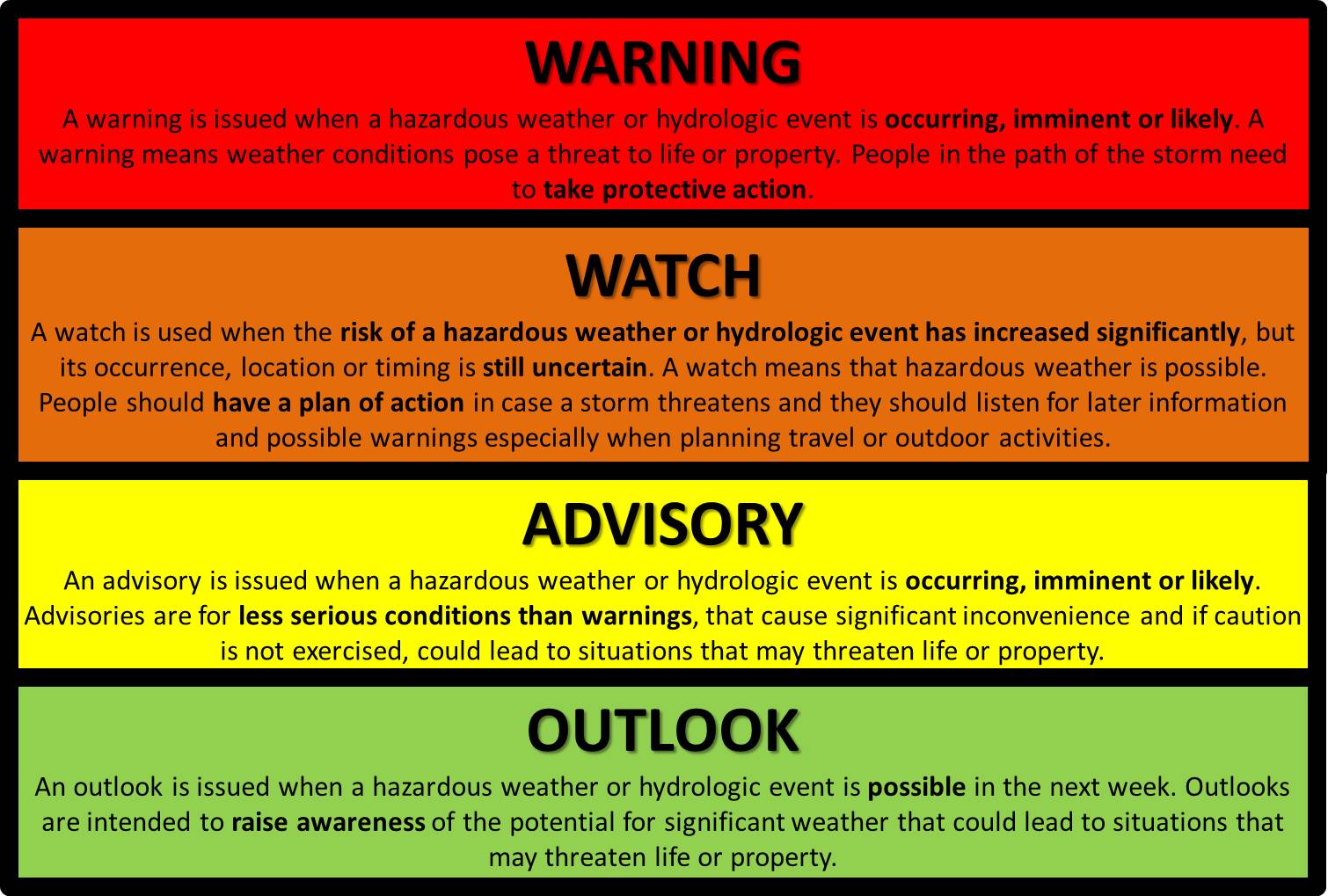Carolinas Storm Watch: Understanding Active And Expired Weather Alerts

Table of Contents
Identifying Active Weather Alerts in the Carolinas
Understanding active weather alerts is the first step in protecting yourself and your family. Knowing the severity levels and where to find reliable information are vital for effective Carolinas storm preparedness.
Understanding Alert Levels
The National Weather Service (NWS) uses a system of alerts to communicate the severity of impending weather events. These alerts are crucial for understanding the potential danger and taking appropriate action.
-
Watch: A watch indicates that conditions are favorable for the development of severe weather. Stay informed and be prepared to take action if a warning is issued. Examples include a Hurricane Watch or a Tornado Watch. This means you should monitor the situation closely.
-
Warning: A warning means severe weather is happening now or is imminent. Take immediate action to protect yourself and your property. A Hurricane Warning, Tornado Warning, or Flood Warning necessitates immediate action.
-
Advisory: An advisory indicates less severe weather conditions, but they still pose a potential hazard. Be aware of the conditions and take precautions as necessary. Examples include a Wind Advisory or a Dense Fog Advisory.
Knowing where to access these alerts is just as important. You can find them through various channels:
- NOAA Weather Radio: A dedicated weather radio provides 24/7 alerts and forecasts.
- The National Weather Service (NWS) Website: This website (weather.gov) provides detailed forecasts and current alerts for your specific location.
- Weather Apps: Popular weather apps like AccuWeather, The Weather Channel, and WeatherBug offer real-time alerts and forecasts.
- Local News Channels: Local news stations provide up-to-the-minute weather updates and coverage during severe weather events.
- Wireless Emergency Alerts (WEA): Your smartphone can receive emergency alerts directly from the government, including weather warnings.
Sources for Real-Time Carolinas Storm Information
Multiple sources for weather information are crucial for redundancy. A single source might fail, so having backups ensures you stay informed during critical periods.
- NWS: Always prioritize the NWS website and alerts as the most reliable source.
- Multiple Weather Apps: Utilizing several reputable weather apps provides a broader perspective.
- Local News: Local news often provides valuable context and updates.
Interpreting Active Alert Information
Understanding the details within an active alert is paramount. Pay close attention to:
- Affected Area: Precisely know if your location is in the path of the impending weather.
- Timing: Understand the timeframe of the impending threat.
- Hazard Type: Know the specific threat (e.g., heavy rain, strong winds, tornadoes).
For example, a Tornado Warning will specify the location and time of the tornado sighting, allowing for immediate action.
Recognizing and Understanding Expired Weather Alerts
While the end of an alert is positive, it doesn't always mean the danger is over.
What Does "Expired" Mean?
An expired weather alert simply means the immediate threat has passed. However, residual effects can linger.
- Flash flooding can continue even after heavy rainfall stops.
- High winds might persist for a while after a storm passes.
- Debris and downed power lines can pose risks long after the event.
Why Understanding Expired Alerts Matters
Knowing when an alert is expired helps to manage anxiety and understand the evolving situation. It prevents unnecessary worry but doesn't imply complete safety.
- While an alert might have expired, it's important to still exercise caution and assess the situation.
- Check for any lingering hazards or potential risks.
Checking for Updated Alerts After Expiration
Staying informed even after an alert expires is critical. Conditions can change rapidly.
- Continue checking weather updates from your reliable sources.
- Remain vigilant, as new alerts may be issued.
Safety Precautions During a Carolinas Storm Watch
Preparation is key to weathering severe weather in the Carolinas.
Preparing for Different Storm Types
The Carolinas experience various severe weather events, each requiring different preparations.
- Hurricanes: Develop an evacuation plan, secure your property, and gather emergency supplies.
- Tornadoes: Seek shelter immediately in a sturdy interior room, away from windows.
- Flash Floods: Avoid driving through flooded areas; water depth can be deceptive.
- Severe Thunderstorms: Be aware of lightning and high winds; take shelter indoors.
Creating an emergency kit is crucial. Your kit should include:
- Water
- Non-perishable food
- First-aid supplies
- Flashlight and batteries
- Radio
- Important documents
Emergency Contact Information
Have a readily accessible list of emergency contacts:
- Family and friends
- Local emergency services (911)
- Your insurance provider
Conclusion
Staying safe during a Carolinas Storm Watch involves understanding active and expired weather alerts, utilizing multiple reliable information sources, and preparing for various severe weather scenarios. Remember the distinctions between watches, warnings, and advisories, and know where to find reliable updates. By following these tips and taking proactive steps, you significantly improve your safety and preparedness. Stay safe with proactive Carolinas Storm Watch practices! Become a Carolinas Storm Watch expert by following these tips!

Featured Posts
-
 Canelo Vs Golovkin Live Stream Results Play By Play And Updates
May 31, 2025
Canelo Vs Golovkin Live Stream Results Play By Play And Updates
May 31, 2025 -
 Sanofi Investiert 1 9 Milliarden Us Dollar In Neue Autoimmuntherapie
May 31, 2025
Sanofi Investiert 1 9 Milliarden Us Dollar In Neue Autoimmuntherapie
May 31, 2025 -
 The Evolving Good Life Adapting To Change And Finding Happiness
May 31, 2025
The Evolving Good Life Adapting To Change And Finding Happiness
May 31, 2025 -
 One Night Only Brandon Inge Back In The Dugout In Kalamazoo
May 31, 2025
One Night Only Brandon Inge Back In The Dugout In Kalamazoo
May 31, 2025 -
 New York Citys 9 11 Response Bernard Keriks Critical Role
May 31, 2025
New York Citys 9 11 Response Bernard Keriks Critical Role
May 31, 2025
